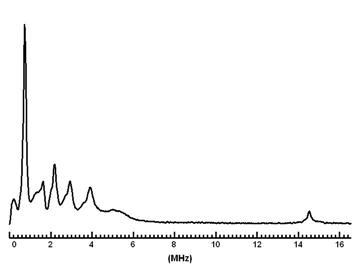
ESEEM stands for Electron Spin Echo Envelope Modulation, and is an experimental magnetic resonance effect which can be observed in pulsed electron paramagnetic resonance experiments.
Nuclear Magnetic Resonance (NMR) spectrometers have for years been built around the idea that powerful pulses of short duration may be used to perturb a sample's magnetization and thereby produce measurable effects which arise from the nuclear magnetic resonances in the sample. This instrument design paradigm has also existed in Electron Paramagnetic Resonance (EPR) spectroscopy, but to a much lesser extent owing to the difficulties in producing precisely timed pulses and achieving time-resolved data acquisition on the timescales necessary in EPR (up to 1000 times faster than NMR timescales).
Echo Envelope modulation arises when there is state mixing of the hyperfine levels. As such ESEEM is most often observed in systems where the nuclear quadrupole coupling is relatively large compared to the hyperfine coupling, i.e. remote 14N couplings. Because the modulation arises from the interference between pairs of excited EPR transitions, oscillations as a function of the difference in frequency between the two arise and give rise to tau-dependent blind spots.
The EPR Lab maintains pulsed EPR spectrometers operating at X-band and Q-band (35 GHz).
Pulsed EPR is used most often to observe the electron spin echo in a paramagnetic system as a function of the time that separates the pulses causing the echo. This technique is called electron spin echo envelope modulation (ESEEM), and is a powerful probe of the radial distribution of magnetic nuclear spins in the environment of the electron spins producing the echo.
Examples of experimental techniques and a deeper discussion of their utility, may be found in the following reviews and references cited in loc.
Selected Bibliography
Mims WB (1972) Envelope modulation in spin-echo experiments. Phys Rev B5: 2409–2419.
Mims WB (1973) Amplitudes of superhyperfine frequencies in electron-spin-echo-envelope. Phys Rev B6: 3543-3545.
Time Domain Electron Spin Resonance, L. Kevan and R. N. Schwartz, editors. Publisher: John Wiley & Sons - New York, Year: 1979, ISBN: 0-471-03814-8
"Pulsed EPR on Disordered Systems: Novel Experimental Schemes" by A. Schweiger, in Advanced EPR Techniques, Applications in Biology and Biochemistry, A. Hoff, editor. Publisher: Elsevier - Amsterdam, Year: 1989, ISBN: 0-444-88050-X
Modern Pulsed and Continuous Wave Electron Spin Resonance Larry Kevan and Michael K. Bowman, Editors. Publisher, John Wiley & Sons. - New York, Year: 1990, ISBN: 0-471-50274-X
Electron Spin Echo Envelope Modulation (ESEEM) Spectroscopy), Sergei A. Dikanov and Yuri D. Tsvetkov. Publisher: CRC Press, Inc. - Boca Raton, FL, USA, Year: 1992, ISBN: 0-8493-4224-4
Principles of Pulse Electron Paramagnetic Resonance, A. Schweiger and G. Jeschke, Publisher: Oxford University Press - Oxford, Year: 2001, ISBN: 0-19-850634-1.